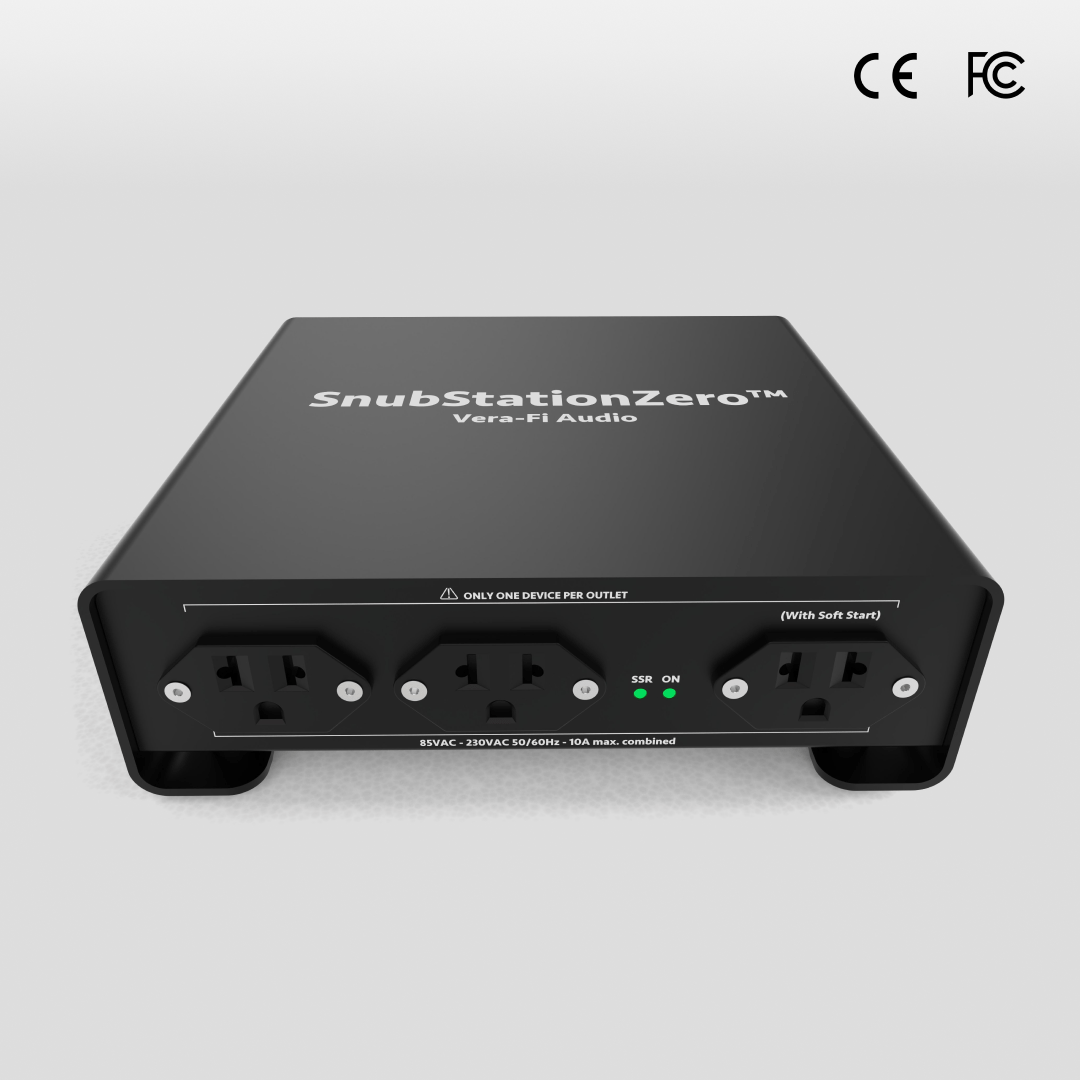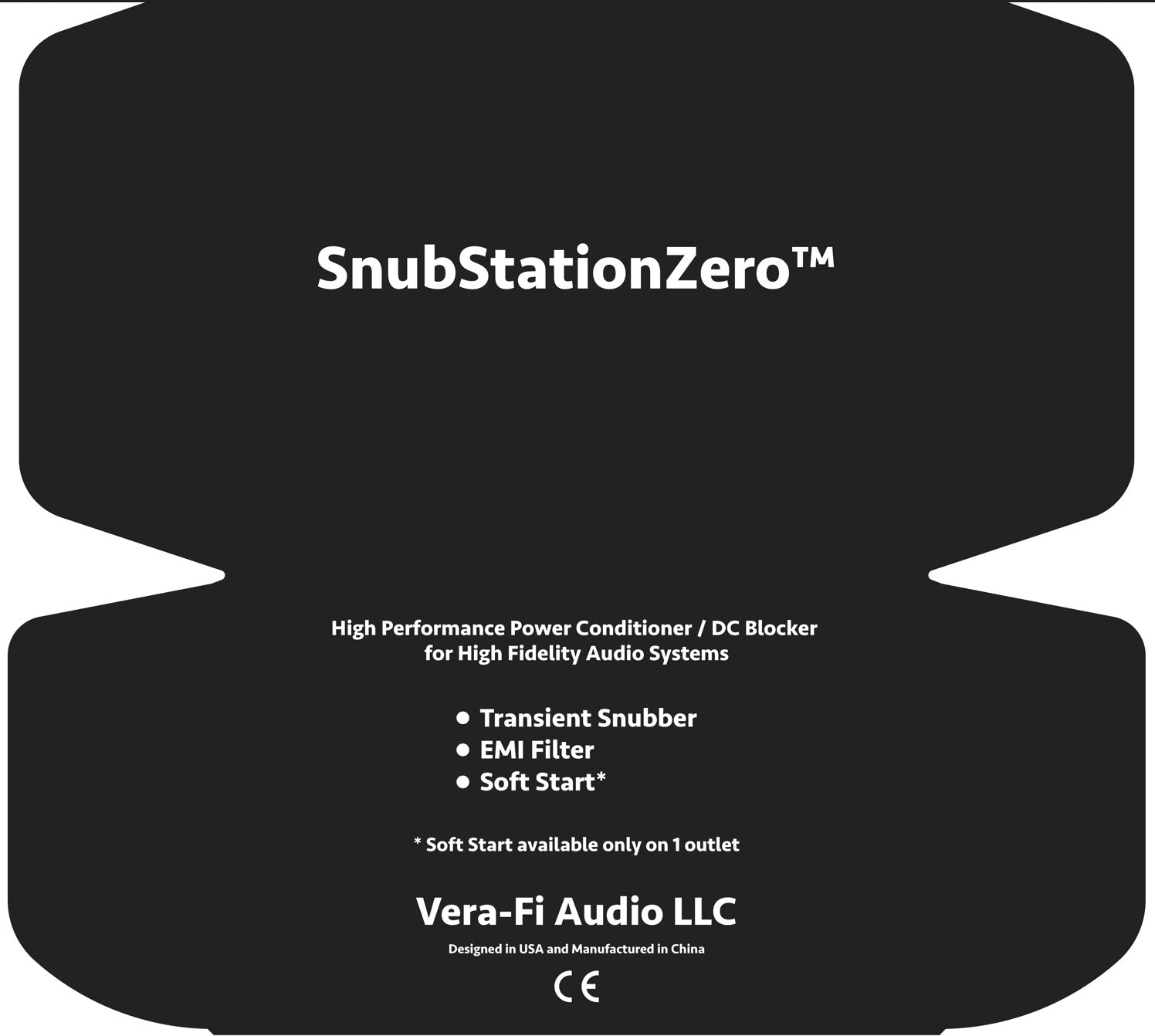Vera-Fi Audio LLC
Snub Station Zero
Snub Station Zero
Couldn't load pickup availability
Recommended Plug Adapters
Recommended Plug Adapters
The Snub Station Zero, Infinity Fuse and Line Noise Black Hole do not support 3-Prong Schuko with grounding pins currently.
But just in case you need grounding, here are adapters we recommend for you to use:
Product Description
Product Description
Snub Station Zero (SSZ) is an all-in-one mains power conditioner for audio/visual components that provides a state-of-the-art DC blocker, high-performance EMI filter, and an automatic soft start circuit that uses a solid state relay (SSR) to prevent large in-rush currents that can damage your equipment during the power-up phase.
Understanding In-Rush Current and Its Impact
The in-rush current spike inflicted on a toroidal transformer often used in high-end audio amplifiers can be up to 20x the nominal rated current, and this large current spike causes magnetostriction—or mechanical stretching in the copper windings every time it is powered up. This is the quickly dissipating buzz sound one often hears when switching on an amp containing a large linear transformer. Over time, this mechanical stress can cause the copper windings in the transformer to fail.
DC Blocker Benefits
The DC blocker uses four premium EPCOS 22,000uF capacitors with audio-grade discrete TO-220 rectifiers in series. These components are designed to handle and eliminate unwanted DC offset in the mains power, protecting your equipment from potential damage.
Custom EMI Filter for Noise Reduction
The custom EMI filter uses two large gauge copper wire CMC chokes and premium film capacitors to block unwanted EMI noise. This ensures cleaner power delivery, which enhances the performance of your audio/visual components by reducing interference.
Soft Start Circuit with Advanced Monitoring
The soft start circuit is unique in that it utilizes a precision Hall-effect current sensor to monitor, in real-time, the instantaneous current flow. When a significant change in current is detected, a solid state relay utilizing low on-resistance MOSFETs are employed to serve as non-contact solid state switches (which never wear out or arc, unlike mechanical relays) to bypass a pair of NTC (negative temperature coefficient) variable resistors that serve to slow down the in-rush current. Once the MOSFETs are engaged, the front panel 'SSR' LED glows to indicate that the SSZ is providing full current to the system.
Main Power and Additional Outlets
The main soft start circuit path can be used to filter a single device up to 10A of current. There are two additional NEMA outlet sockets that can provide power for smaller accessories that do not need the soft start feature but will benefit from the DC blocker and premium German-made Schaffner integrated EMI filter module.
Ideal Usage Scenarios
With three outlets total, the SSZ is ideal for powering a main power amp with the soft start outlet, a preamp and a DAC, etc. with the additional non-soft start outlets.
The SSZ is designed in the USA and assembled in China using only premium-quality components.
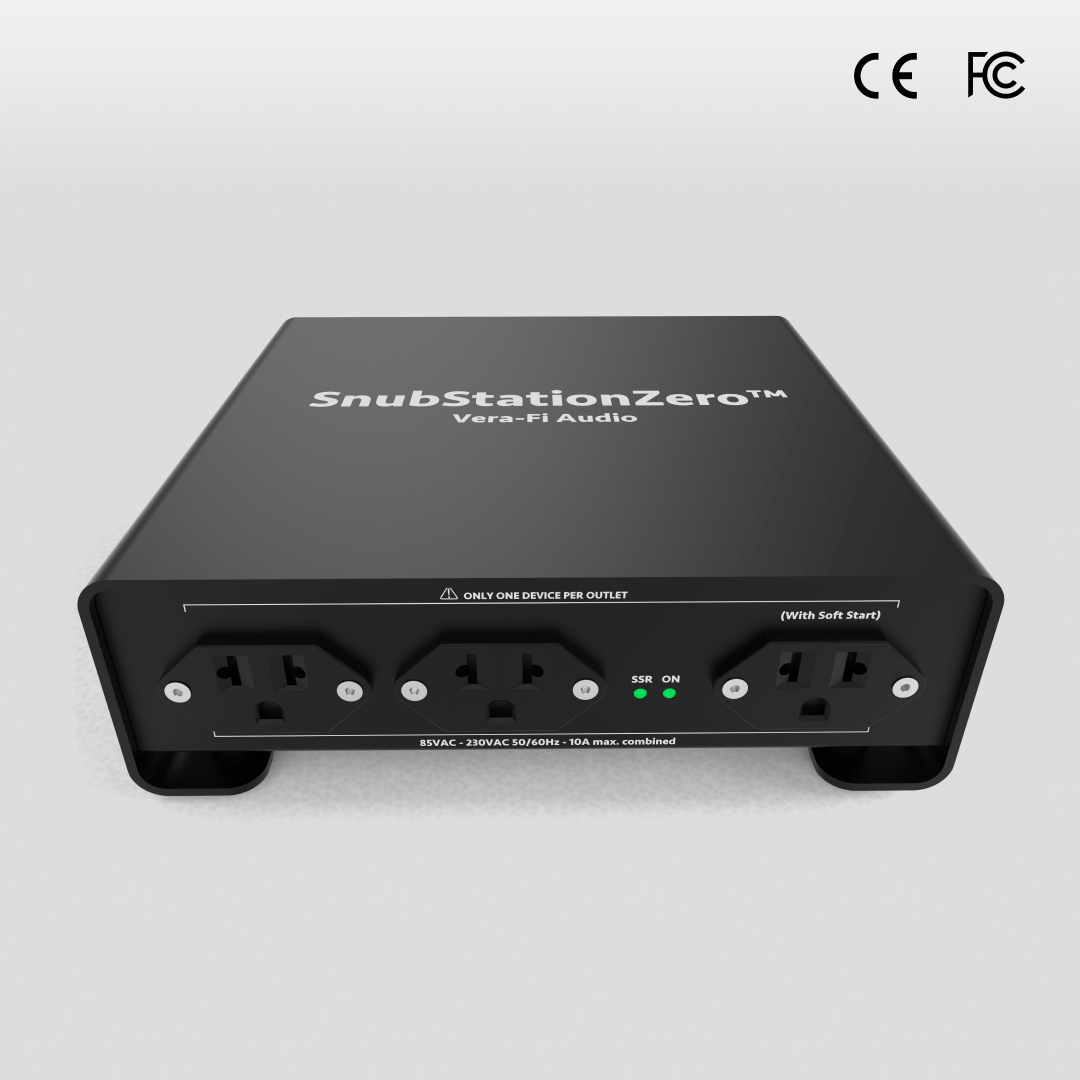
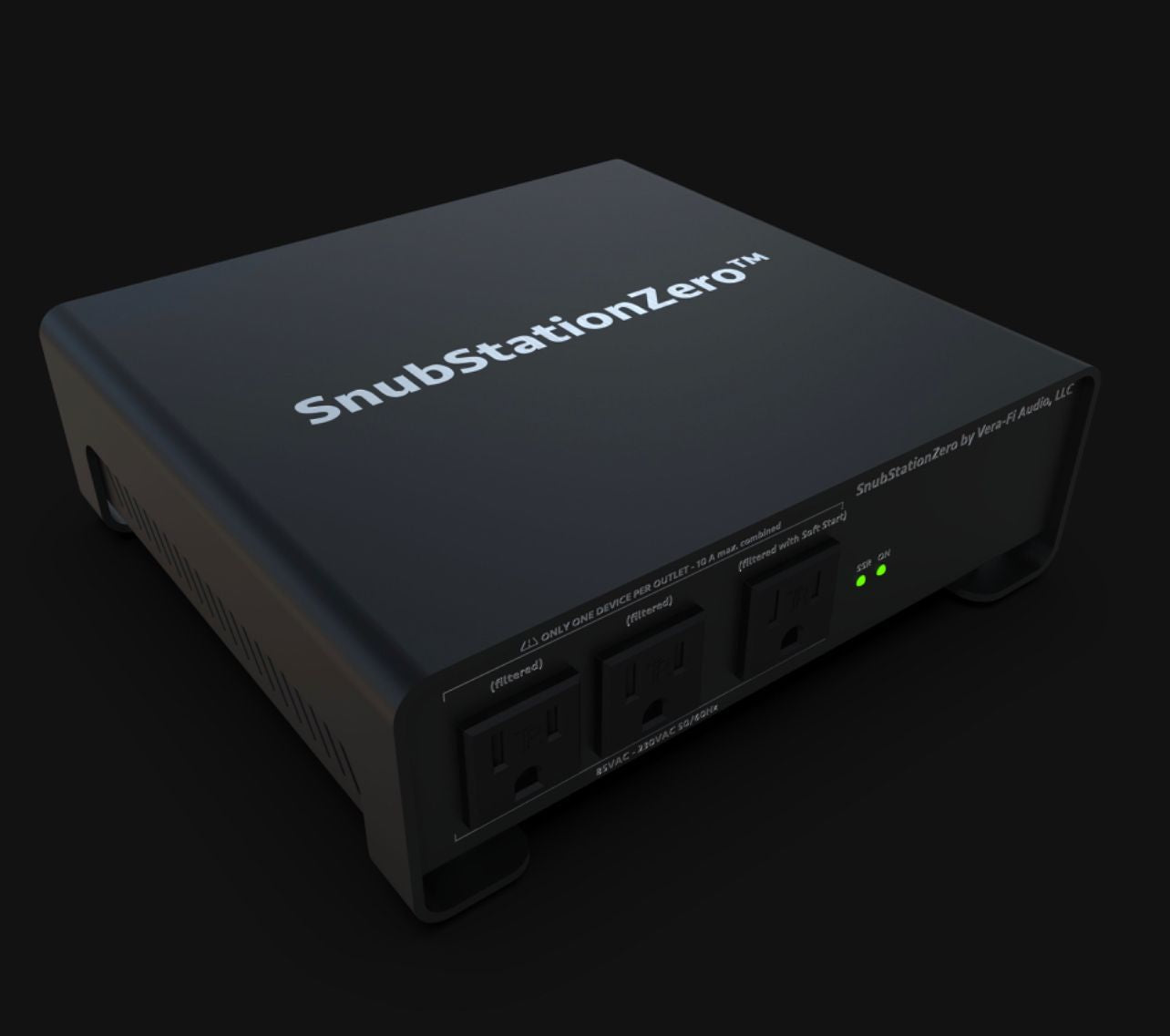
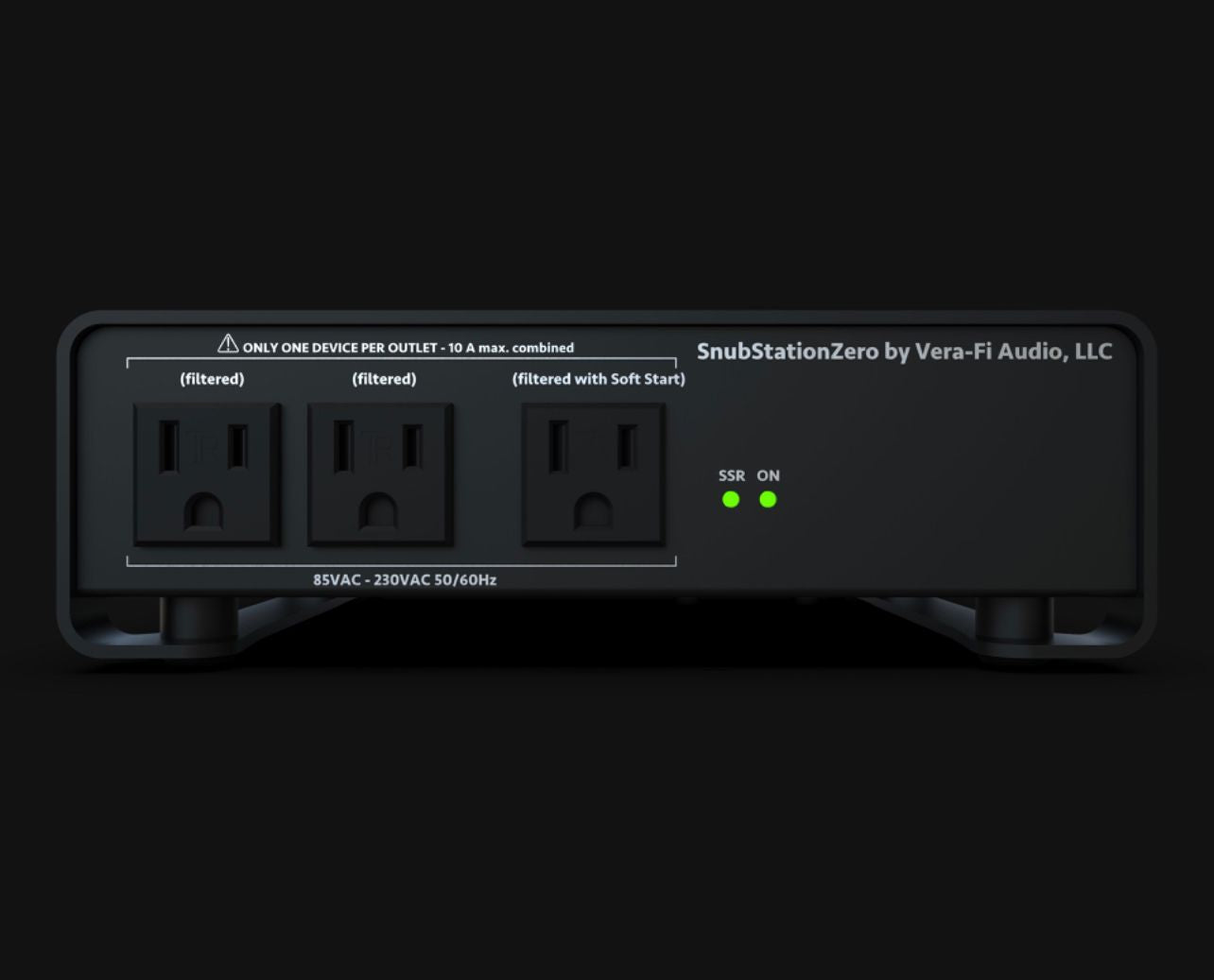
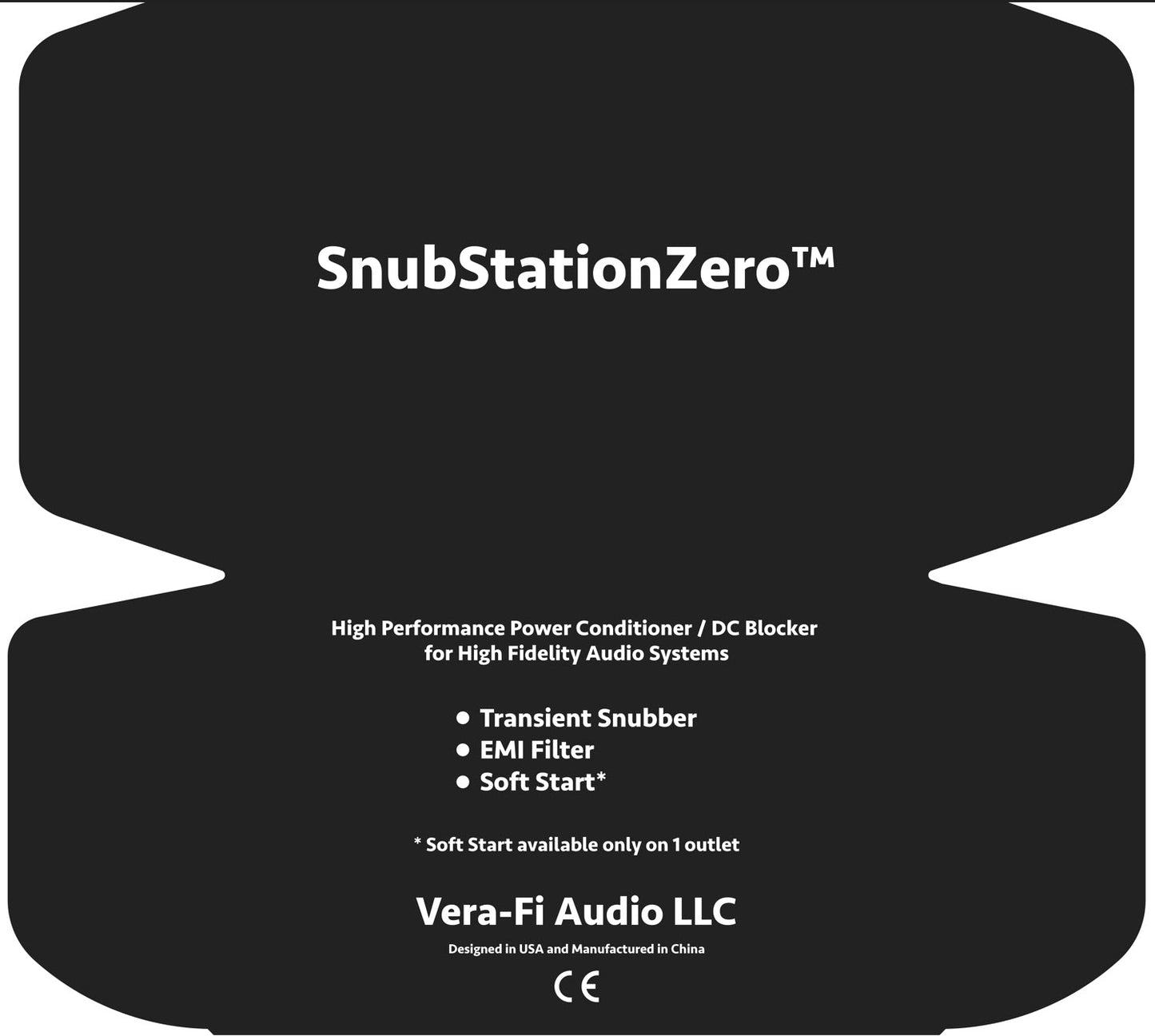
I recently integrated the SSZ into my system, alongside the LNBH, and the two proved to be highly complementary. While the LNBH focuses on cleaning high-frequency EMI/RFI noise and lowering the noise floor at the source, the SSZ stabilizes the foundation by blocking DC offset, filtering mid/low-frequency interference, and adding a soft-start function. Together, they form a balanced approach to power conditioning, one addressing refinement at the top, the other ensuring solidity and control at the base.
With the SSZ in place, the presentation gained a calmer, more grounded character. The soundstage opened with greater depth and spatial definition, and instruments locked into position with more natural spacing. Bass and mid-bass became richer in texture yet remained controlled, while vocals and strings carried more body and emotional weight. High frequencies smoothed out without losing detail, giving the music a more relaxed and effortless quality.
Dynamics also benefited. Quiet passages now emerge from a darker, quieter floor, while peaks and transients are released with greater ease and natural flow. The LNBH enhances openness and fine detail, while the SSZ reinforces stability, coherence, and weight. Used together, they help the system breathe more freely, making listening both technically refined and musically involving.
The SSZ is far more than a protection device, it is a meaningful sonic upgrade, especially when paired with the LNBH. This combination lowers noise across the spectrum, stabilizes dynamics, and enhances musicality in a way that feels both natural and convincing. For me, they turned listening into a more effortless and emotionally engaging experience.
Still burning in, but my sound has improved.It's a change that's hard to describe.I can't say it's added more bass or detail,just that things sound a bit closer to being perceived as real than before.Definitely something is going on.Vinyl and cd's both sound better now than they did and I thought things were pretty good before.So for me this has been a welcome addition.
Klipsch Cornwall 1v, bi-amped with--Schitt GHorn for bottom and a Martin logan depth sub
Coherent sound Frankenstein 300B monos for top
Coherent sound statement linestage
JC3+ phono
SME 10/V Benze lo4 mc
Bryston bcd3 as transport
Ps Audio direct stream dac mk11
All wireworld eclipse 8 cables
Room treatment
And of course the Snub station and the Line noise blackhole
I didn’t expect much with all my power conditioning but boy right out of the box these power components improved the SQ noticeably. Volume seemed to increase, dynamics improved and 3D sound stage expanded. Thanks for the great products and amazing value. Now that the LNBH and SSZ have had some nice break-in hours, moving my Mainstream and Snubway to my modem/router roon core room and upgrading the LNBH/SSZ power cords all I can say is WOW. My system has never sounded better. Separating my Power Amp, Preamp and DAC away from all my other electrical devices and having 2 power conditioning set ups has really improved things. As an added bonus with these two devices I no longer need my Stack Audio SmoothLan, EtherRegan and external clock. They just no longer add improvement. Nice to clean up the space and simplify.
3 New Products: My Review:
3 New Products: My Review: The NEW Ver-Fi: Products:
1. Line Noise Black Hole (LNBH),
2. Snub Station Zero (SSZ),
3. Infinity Fuse.
Mark asked me if I would like to try a few of his new products, and as a big time Audiophile tweaker (however my wife would describe me as a nut) I couldn’t resist.
In this review I will try to show that I have tried these units everyway possible within my system (see my profile) to remove any doubts as to how they performed.
First off, using the new Infinity Fuse with a Graphene slug into my Lumin X1 was instant success. This one unit contributed to a much wider soundstage and just a general upgrade in overall sound quality. So, this item will remain, no matter how the rest of the Veri-Fi equipment performs. BTW, it replaced a Synergistic Research Master Fuse.
Then I tried the LNBH and SSZ in my “computer/streaming room”. This room includes my Modem/Router, Etherregen, AfterDark clock, AfterDark linear power supply, and some other sundry items (printer etc.). I let the system stream music for a few days, and after that time, honestly, I could not hear any additional sonic improvement or change of any sort.
So, the next day I relocated the LNBH and SSZ into my audio system. I think I read that these items should be used in Tandem. I am using an AQ Dragon source power cord (from my AQ Niagara 7000 power conditioner) that was plugged directly into my Lumin X1 but now I plugged it into the LNBH and with a short DIY jumper power cord from that unit into the SSZ. And since the Infinity Fuse unit was a definite keeper, I also added an additional short jumper DIY AC cord to plug it into the Lumin X1. I should add that the AC input and outlets are on opposite ends of the devices which made daisy chaining them difficult.
When I played the system with familiar tunes it seemed that the soundstage was pushed way back, kinda sounded like into a tunnel and not as lively as I remembered the tunes before.
So, for “Shts & Giggles” I removed the Veri-Fi previous versions of the “Snubway & Mainstream” devices from the Audio system. (My thinking was perhaps there is too much filtering of the same type). And sure enough, the liveliness returned, so make note of this: the original Snubway and Mainstream do not mesh well with these new products.
Question:
Should I plug all of this directly into the AC wall outlet instead of the AQ Niagara power conditioner 7000?
To answer that question, I then went ahead and plugged the daisy chained trio directly into the dedicated wall outlet. And at first listen, I thought, hmm not bad. But after several back-and-forth trials, I decided that having these units plugged into the AQ 7000 is better. Perhaps different power conditioners may react differently. So, experiment is the word.
After a week of listening to the trio as above, the last and final test would be to return to the beginning, that is; removing the LNBH and SSZ from the system. Note: I have already determined that the Infinity/graphene fuse was a definite instant plus, so it will always remain.
Conclusion:
Well first, I can conclude that that a week of burn/breakin was helpful, as it does for most new equipment, and it may improve further with more use. Then, I have found in the past that using a new item for a period of time, that “new” sound, becomes the standard, (you get used to it) and only after removing it can it be judged on the effectiveness, (if any) good or bad. Do I miss it?
So, after a week of playing my favorite tunes with the LNBH and SSZ devices connected, I then disconnected them and went back to my original set up, (but, again with the Infinity Fuse and the Graphene slug still installed).
At first, I thought the midrange was richer but as I continued listening, I began to realize that the music had lost that “sparkle”. By that I mean, the feeling of extreme openness with images clean and deep with a liveliness that I guess I would say, it no longer sounded “live”.
I then re-connected the LNBH and SSZ devices and ahh, that very open sound returned.
The Downside?
Several short power cord jumpers are needed and as mentioned, daisy chaining them can be difficult.
Sound Quality Wise?
So, my conclusion is that, yes, these devices are a Definite Plus and with whatever is inside them, improved the sound for this old Audiophile. Your music will be released into your room and sparkle the soundstage, enjoy the new performance!
Wow! My system has never sounded better! Highly Recommended!
BTW, my wife still thinks I’m nuts…
ozzy
I have two in my systems, both used in combination with the Line Noise BlackHole. The one in my all-analog system connects my PS Audio Stellar phono preamp, ProJect Classic EVO turntable, and my PrimaLuna EVO 300 tube integrated amplifier, which also has a Swiss Digital Fuse Box between the amp and SSZ's high-current, soft-start AC outlet. I'd been slightly troubled by a slight "buzz" in the system, which I attributed to either the Ortofon Quintet Bronze MC cartridge, the phono preamp, or the tube amplifier. After inserting the new VeraFi power conditioning equipment, the buzz was completely gone, and in its place is complete silence! The combination has replaced an AudioQuest Niagara 1200, which is a good unit, but not in the same class as the VeraFi LNBH, SSZ, and SDFB -- I have been totally shocked by the improvement, which stretches across every possible metric of analog playback.
The same setup is in my digital source system, except with an Infinity Fuse unit replacing the Swiss Digital Fuse Box. In this case, a new Boyuurange A50 Mk III SET 300B tube amp is plugged into the Infinity Fuse, then into the SSZ's soft-start outlet. My Aurender A1000 music server/network player is also connected to the SSZ, as well as my S.M.S.L. VMV D2R DAC. The soft-start outlet is perfect for extending 300b tube life, and the overall system sound is astonishingly good! I'm playing through a pair of vintage Klipsch RB3 Reference monitors (94 dB/watt, 3.8 ohms) and the room synergy is now beyond perfect with the VeraFi Equipment!
Articles about Vera-Fi Audio's Power Optimization Collection

Audio Pursuit
The SSZ and LNBH nail the key point in audio, improving the quality of your listening experience
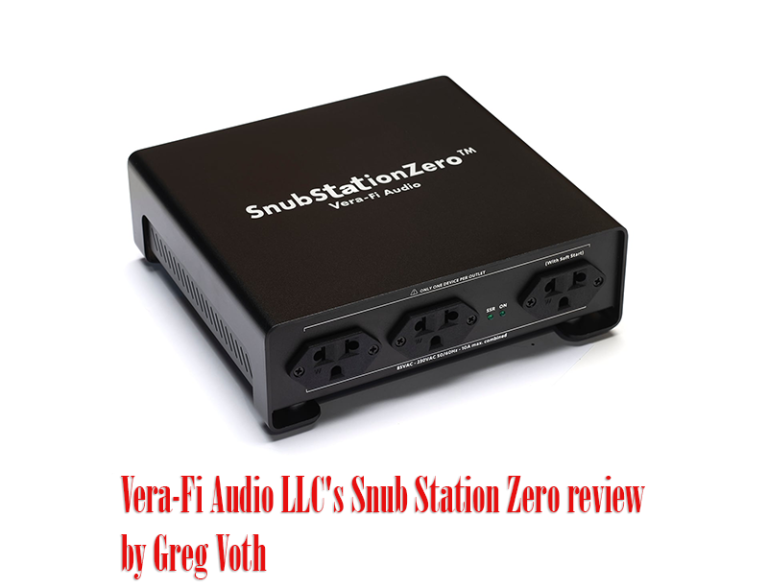
Stereo Times
The Snub Station Zero deserves an audition

Tone Publications
Distilled | Vera-Fi Audio Snub Station Zero
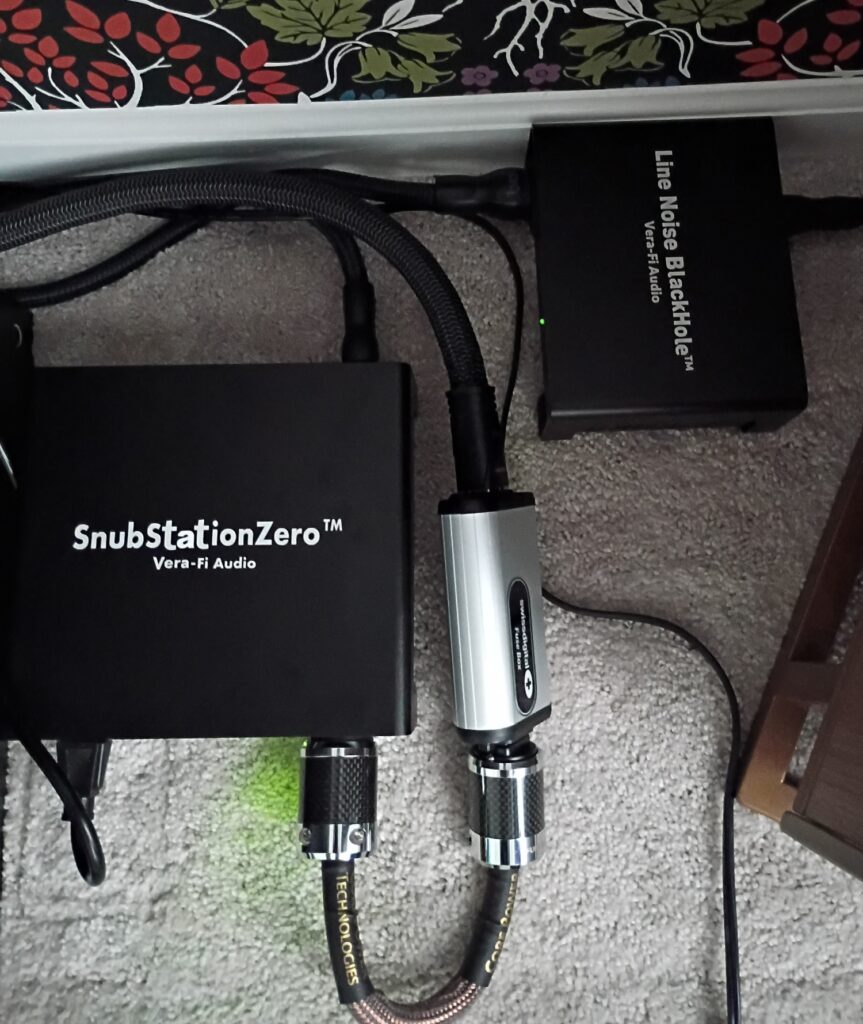
Positive Feedback
Serious AC Power Optimization that has Rocked my World!
Frequently Asked Questions (FAQs)
Where can I find Vera-Fi Audio warranty information?
You may find information about warranty here.
Follow Us!
Subscribe to our mailing list for insider news, product launches, and more.
- Choosing a selection results in a full page refresh.
- Opens in a new window.
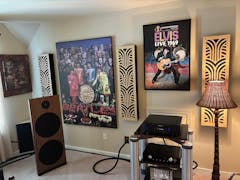
I have mine for a week or so; I have more on order, including the Snubway. But just this one unit has made an impact for the positive, so I am hoping to build on this. It is outlet d, and depending on which outlet it is plugged into, the results can vary, depending on the outlet position in the room. I put my in the Garage by the 1st AC outlet n to the fuse box after reading on that would be a good place for one unit, and they were right, right away the TV Sound bar and the 3 subwoofers connect sounded more dynamic, and the sound was more natural and with more body, what surprised me was on the 2nd level where my Stereo is it made a positive impact there also, I went down and unplugged it and went up and listened again and there was a drop off in presence, body and weight to the music as well as lacking the detail, piano is what I used with a stand up bass, to keep it simple, all sound more real with the one unit plugged into the outlet by the fuse box, so one is staying when I get the others I will built from there and see the extra ones impact, Mark is going to send me a package that he feels will work best for my system, Mark been great even took the time to call me to answer some questions on his products and which would be best for my needs. So try different outlets, let the unit burn-in for a week or so, the only time it hurt the sound was when I put it in the outlet before the Core balanced line conditioner; those two did not play nice together at all, lost mid-bass and bass, sound was thin, but that was the only time, I will try a Snubway there when I receive it. A good product, give it a try.
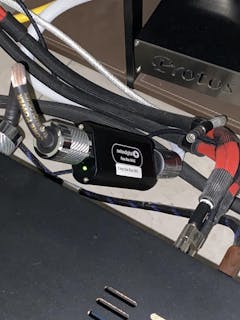
Really good uplift in soundstage, tonality and dynamics! No doubt about it or placebo!
The sound feels more pure!
At around 300 hrs like clarified by mark , the effect becomes very obvious!
I will probably go one for amp and one for streamer .
Bravo!
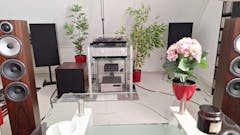
I've recently replaced my B&W 705 S2 standmount and B&W ASW608 sub by a new B&W 704 S3 floorstander. Incredibly good speakers, especially considering the price. The dual woofers reach down to 48Hz, but I still missed that last octave. I was looking for a suitable REL sub but after seeing so many good reviews about the Vanguard Caldera 12" Active Subwoofer I decided to give it a try. I thought it would be difficult to get one in the Netherlands. However thanks to Ace from Vera-Fi, he managed to do that; my sub arrived on location in 11 days. The price-performance ratio is out of this world. I thank Ace for all his efforts and Vera-Fi for an incredible deal.
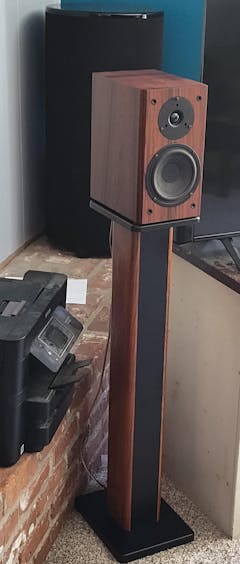
I bought these because I have been in love with Rosewood veneer since I first saw it as an extra cost option for some $5000 speakers in the '90s. Never expected to be able to afford a pair of Rosewood veneered speakers, but then found these for under $300. I pulled the trigger, ASAP.
When they arrived, I gave them >50 hours of 85dB in room playback of the radio with them facing each other under a comforter and wired out of phase to damp down the noise. After this, I gave them a listen. Beautiful, and they sound spectacular for their price point. I felt like I won the lottery; a scratcher, not the PowerBall, but still :) I was used to a bookshelf pair w/ lite mid-bass response and slightly "crisp" highs, and these (in direct comparison) had excellent mid-bass response and are just a bit laid-back in the very highest registers to my ears. I use them with a 500-watt RMS ported 12" subwoofer crossed over at 100Hz and get good output from them with an 80-watt per channel RMS amp. Like easy, no strain, >90dB at the listening position 12' away kind of "good output". For movies, tv, and music. Plenty for me.
If you like beautiful speakers, good sound (though not detail monsters like the AMT-tweeter based speakers I have in the bedroom), and spectacular value don't be afraid to pull the trigger on these Vanguard Scouts. Just please don't expect "giant killing" sound quality for under $300, and I promise you'll be happy with your purchase.
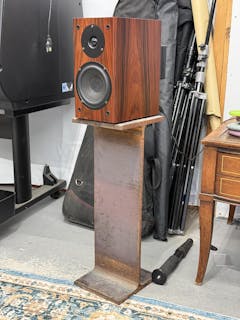
I’ve never had good speakers to listen to music on, so this was a big leap for me. I bought the Vera link combo and the 10” caldera to go with them. Mark has answered every question of mine personally and he advised that I connect the vera-link to the high pass input and then out put with some cables to the speaker and it works like a charm! Even though I am listening to music through my bluetooth on my iPhone, it sounds absolutely amazing!!

Excellent built quality, a ported sub that sounds closer to sealed sub and for only 348 euros? Insane but true, the Caldera 12 will sound just as good in my room for music or home theater, i cant recommend this sub enough! Go dual for bombastic room filling low notes imo. The only gripe i have is the auto on off which turns the sub off after only 10 seconds, i would recommend at least 1+ minute of inactivity to turn off so lets hope they boys in the lab will sort this out on the next batches! Excellent job Vera Fi team!

"First, I'd like to thank **Mr. Ace**. He was a great help with the delivery.
The **SnubWay - Noise Defender** has enhanced the audio system. A new level of sophistication has been added to the system, which was previously a straightforward 'Main Stream' setup.
Firstly, I feel like the **soundstage is wider**.
And I feel like it has captured the **subtle vibrations and noise**.
Frankly, I had been briefly tempted by Chinese-made products due to their price advantage.
However, **vera-fi-audiollc** clearly demonstrated the **technical gap** between those products and this one.
Thank you."

This is my first Hi-fi set of speakers I have ever bought. Before this, I listened to BOSE speakers.
WOW.... what an upgrade these Vanguard scout speakers are!!
I had to wait a couple months to get my order (because of tariffs), but Mark and his team were really amazing at answering all of my questions and updating me with the progress of my order.
I ordered the Caldera 10 sub, vera-link amps, and the scouts and Mark helped me to understand how to plug the vera-links bluetooth amps into the subwoofer through the high-pass input and output through the high-pass directly to the right scout speaker and it works like a charm! I couldn't be happier!
You will see two pics in my review of the back of the right vanguard scout speaker, because I wanted to show you that if you have to peel the velcro off of your speaker and place it elsewhere, it doesn't leave any residue to clean up! It's not a huge deal, but it certainly made my life easier.
I am a fan for life and will be ordering some of the new things they are working on in the future!

I purchased three Caldera 10's to go with my three pairs of Scouts. I love them, so I purchased 4 more to get small rooms 2.1 & large rooms a 2.2. I love speaker systems but I haven't had a good set up for years. I looked into this for months. I didn't know what my sound system was missing till I got the lower end filled in.

Great speakers, right in my budget. I purchased one pair, broke them in, loved them, and then purchased 2 more pairs. I had the option of ceiling speakers but bookshelf sound so much better. The Scouts allowed me to get great sound and budget. I have them in several rooms now. 2.2 in the main rooms and 2.1 in the small rooms. When connecting a Caldera 10 it was suggested to put a HPF 70h on the Scouts. I haven’t been able to find a good low cost 70h, closest so far is 80h $25. I purchased (3) pairs of Scouts and (7) Caldera 10. So HPF is important to focus more on the mid and high’s. Really really like Vera-Fi Scouts and Caldera’s!!!

